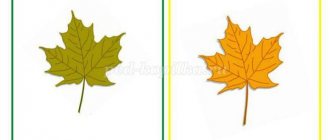Didactic games aimed at developing color perception
DIDACTIC GAMES AIMED AT DEVELOPMENT
COLOR PERCEPTION
Gifts for Fairies
Option
I Purpose.
Reinforce ideas about colors. Teach children to highlight colors, distracting from other characteristics of objects (shape, size, functionality)
Material.
Fairy dolls of different colors and shades. Toys and objects of different colors.
Children are invited to give a gift to the Flower Fairy. only the same color as the fairy herself.
At the initial stages, one fairy doll of a certain color is used.
Option
II Purpose.
Reinforce ideas about colors. Teach children to highlight colors, distracting from other characteristics of objects (shape, size, functionality)
Material.
Fairy dolls of different colors and shades cards - “rugs”, two or three geometric figures of each color of different shapes and sizes (different materials are used).
Children are invited to give gifts to the Colored Fairies. Hand out colored “tickets”, name the color, shape, size.
Find a flower of the same color
Target.
Teach children consistent visual examination and description of an object, its shape, indicating proportions, color, shade.
Material.
Typesetting canvas. Flowers of different colors, shades and sizes.
Place a butterfly on a flower of the desired color
Target
. Teach children consistent visual examination and description of an object, its shape, indicating proportions, color, shade.
Material
. Typesetting canvas. Flowers of different colors, shades and sizes. Butterflies.
The teacher names the flower or describes its distinctive features. He offers to find it and plant a butterfly on this flower.
Collect a seven-flowered flower
Target.
To consolidate children's knowledge about the relationship between the colors of the spectrum.
Material.
Green typesetting canvas. Heart petals 7 colors, 4 pieces of each color.
Find two identical hearts
Target.
To consolidate children's knowledge about the relationship between the colors of the spectrum. Learn to correlate objects by size and color.
Material.
Green typesetting canvas. Heart petals of different colors and flower sizes, 2 pcs of each color.
Sunbug
Target.
Introduce children to colors and shades and their names. Learn to compare objects by color by placing them next to each other.
Material.
Flowers with 6 petals of different shades - blue, green, red, 1 flower with multi-colored petals. The sun bugs are the same shade as each of the petals.
Choose an item by color
Target.
Exercise children in matching and grouping objects by color.
Material.
I
option.
Puzzle cards with colored objects and center squares in 6 primary colors.
II
.
Puzzle cards with colored objects and middle puzzles of primary colors and shades.
Children choose the middle of the puzzle of any color they like and select cards of the corresponding color.
Warm and cool colors
Purpose.
Reinforce the idea of grouping the colors of the spectrum into warm and cold.
Material.
Picture of the sun and snowflakes, circles of different colors of the spectrum and their shades.
Children are asked to identify the colors that suit the sun and those that suit the snowflake, and explain their choice.
Choose a palette
Target.
Teach children to find the color palette in which the picture was created.
Material.
Picture cards made in different colors and genres. Palette cards.
Children choose a large card with an image and from the palette cards select the one that matches the image. (For convenience, the same numbers are glued on the back side - the number on the card and the number on the palette correspond to each other).
The game can be played as a competition: who can choose the most correct palettes for the pictures.
Make a Dymkovo pattern
Target.
Teach children to make a pattern based on Dymkovo painting.
Material.
Elements of Dymkovo painting carved from dish sponge.
I'll be the hairdresser
Target.
To develop children's ability to trace patterns and complete drawing and cutting out the “hairstyle”.
Material.
Portrait templates, colored paper of different shades and formats, simple pencils, scissors.
Children model their hair using a portrait template.
Collect a flower
Target.
Practice the ability to select halves of one flower in accordance with color and shade.
Material.
Half cards featuring flowers, varying in color and style.
From the proposed set of cards, children make a flower. When all the flowers have been collected, children are asked to combine the cards into groups according to the style of the flower image.
Choose a vase for a flower
Target.
To develop color perception in children - the ability to distinguish up to five shades of the same color, and to correlate these shades with each other.
Material.
Cards, five shades of the same color, with flowers and pots.
Make a picture from geometric shapes
Target.
Teach children to make silhouette figures using geometric shapes. Develop imagination. Fix the names of the primary colors.
Material.
Sample cards, a set of geometric shapes of different colors and sizes.
Columbus egg
Target.
Teach children to make silhouette figures using all the parts, attaching one to the other, without overlapping one on top of the other. Develop sensory abilities, spatial representations, and integrity of perception.
Material.
An oval measuring 15x12cm, cut into 9 parts: 3 triangles (2 large, 1 small), 2 figures similar to a quadrangle, one of which is round, 4 figures (large and small), similar to a triangle, but with one side rounded. To make the game, we used cardboard, identically colored on one side and multi-colored on the other. Sample cards.
At the initial stage, children find similarities between the shapes of game elements and real objects.
Next, children are asked to create a silhouette figure according to the proposed model.
When children have mastered the techniques: they independently invent and make figures.
Tangram
Target.
To train children in the ability to compose new images from existing geometric shapes, based on a model and according to plan.
Material.
A square of cardboard, painted on one side with one color and multi-colored on the other, cut into 7 parts: 2 large, 1 medium, 2 small triangles, a square and a parallelogram.
Middle group
Older preschoolers should know where flowers grow, what features and properties different types of plants have. It is important to instill in students a love for the nature of their native land. We must not forget about the physical activity of the children.
Where does the flower grow
For the game, prepare pictures of flower beds, fields, forests. Make cards depicting flowers familiar to the children. Invite the players to distribute the cards according to the pictures of growing places.
Flower drawing competition
By participating in an art competition, children develop imagination, creative skills, and color perception.
For the competition, purchase or pick a large flower from your garden: tulip, peony, rose, sunflower, iris or other. Children prepare art supplies and sit at easels, if available, or tables. From the finished works they put together an exhibition and choose the winner of the competition whose work they liked the most.
Flowers
The didactic game “Flowers” develops speech skills, imaginative thinking, and the ability to select descriptive features.
Ask a question and let the children give descriptions. You cannot repeat yourself; for each correct answer the player receives a point. The participant with the most points wins.
Here are sample questions:
- What kind of rose? – beautiful, red, lush, fragrant, tender;
- What flowers have spines? – rose, rose hip, cactus, blackthorn, burdock;
- What flowers are perfume made from? – jasmine, lavender, rose, lily of the valley, peony;
- What plants are honey made from? – dandelion, linden, acacia, clover;
- What flowers are yellow? – sunflower, dandelion, narcissus, buttercup.
Flower catch-up
Each player chooses the name of the flower; they should not be repeated. The players decide by lot who is catching up. Let it be “Cornflower”. He names some other plant, for example, “Dandelion”. The player who chose the name “Dandelion” runs away. "Cornflower" catches up with him. When “Dandelion” feels like it is about to be overtaken, it may say out loud another flower, such as “Chamomile.” Then “Romashka” has to run away, “Cornflower” switches to her. If “Dandelion” does not have time to pronounce the word and is caught, then it becomes catching up.

